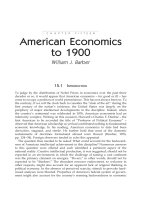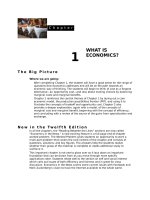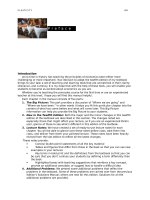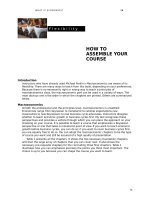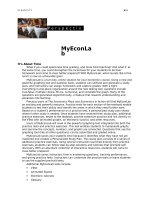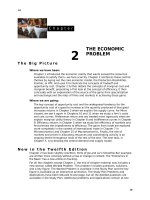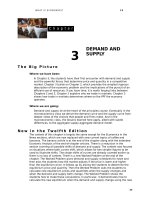Answers to review quizzes marcroeconomics 12e parkin chapter 15
Bạn đang xem bản rút gọn của tài liệu. Xem và tải ngay bản đầy đủ của tài liệu tại đây (957.48 KB, 17 trang )
W H AT I S E C O N O M I C S ?
Answers to the
Review Quizzes
243
1
5
INTERNATIONAL
TRADE POLICY
Page 416
1.
Describe the situation in the market for a good or service that the United
States imports.
The goods and services the United States will import are those in which the United
States has a higher opportunity cost of production relative to other countries. In
those markets the U.S. no-trade price is higher than the world price. With trade the
quantity produced in the United States is less than the quantity consumed and the
difference is imported.
2.
Describe the situation in the market for a good or service that the United
States exports.
The goods and services the United States will export are those in which the United
States has a lower opportunity cost of production relative to other countries. In
those markets the U.S. no-trade price is lower than the world price. With trade the
quantity produced in the United States exceeds the quantity consumed and the
excess is exported.
Page 417
1.
How is the gain from imports distributed between consumers and domestic
producers?
Consumers gain from imports and domestic producers lose from imports.
2.
How is the gain from exports distributed between consumers and domestic
producers?
Consumers lose from exports and domestic producers gain from exports.
3.
Why is the net gain from international trade positive?
The net gain from international trade is positive because the gain to the winners
exceeds the losses to the losers. For instance, in the case of an imported good, the
gain to consumers exceeds the loss to producer so society gains on net. The
situation is similar for exports: The gain to producers exceeds the loss to
consumers..
Page 423
1.
What are the tools that a country can use to restrict international trade?
243
244
A country can use tariffs, import quotas, other import barriers such as health,
safety, and regulation barriers, and voluntary export restraints to restrict
international trade. Export subsidies also decrease other countries’ exports and
restrict their international trade.
2.
Explain the effects of a tariff on domestic production, the quantity bought,
and the price.
A tariff raises the domestic price of the product. The higher price increases
domestic production and decreases the domestic quantity purchased.
3.
Explain who gains and who loses from a tariff and why the losses exceed the
gains.
Domestic consumers lose from the tariff. Domestic producers gain from the tariff.
The government also gains revenue from the tariff. But the gain to producers plus
the gain in government revenue is less than the loss to consumers, so on net a
tariff creates a social loss. There is a social loss for two reasons: First, high-cost
domestic production expands, so society uses more resources producing some
high-cost units of the good than it would use if low-cost foreign units were
purchased. Second the high price leads domestic consumers to decrease their
consumption of the good, thereby robbing society of the benefits these units would
have produced.
4.
Explain the effects of an import quota on domestic production, consumption,
and price.
An import quota raises the domestic price of the product. The higher price
increases domestic production and decreases domestic purchases.
5.
Explain who gains and who loses from an import quota and why the losses
exceed the gains.
Domestic consumers lose from the import quota. Domestic producers gain from
the import quota. The importers also gain additional profit from the import quota.
But the gain to producers plus the importers’ profits is less than the loss to
consumers, so on net an import quota creates a social loss. There is a social loss
for two reasons: First, high-cost domestic production expands, so society uses more
resources producing some high-cost units of the good than it would use if low-cost
foreign units were purchased. Second the high price leads domestic consumers to
decrease their consumption of the good, thereby robbing society of the benefits
these units would have produced.
Page 427
1.
What are the infant industry and dumping arguments for protection? Are they
correct?
The attempt to stimulate the growth of new industries is the infant-industry
argument for protection, which states that it is necessary to protect a new industry
from import competition to facilitate the growth of that industry, making it
competitive in the world markets. This argument is based on the concept of
dynamic competitive advantage. Learning-by-doing is a powerful engine of
productivity growth. However the learning-by-doing argument for protection only
works if the benefits also spill over into other industries and other parts of the
economy. This is rarely the case, as the entrepreneurs of infant industries and their
financial supporters take this risk into account and all returns usually accrue only
to them, not to other industries. And it is more efficient to subsidize the infant
industry needing protection than it is to protect it by restricting trade.
The dumping argument for protection states that a foreign firm is selling its
exports at a lower price than its cost of production. Foreign firms trying to
monopolize the international market may use this practice. Once the competition is
244
W H AT I S E C O N O M I C S ?
245
gone, the foreign firm will raise prices and reap profits. This argument fails for
several reasons. First, it is virtually impossible to detect the occurrence of dumping
since it is impossible to verify a firm’s production costs. The test most commonly
used is if the export price is lower than the import price. This test only examines
the supply side of the two markets and ignores the demand side. If the domestic
market is inelastic and the export market is elastic (which is almost always the
case) then it is natural for a firm to price the domestic goods higher than the
exports. Second, it is difficult to see how a global firm could have a monopoly for
the goods or services it exports. There are too many foreign suppliers (and
potential suppliers), making global competition too extensive for a monopoly to
exist in the global market. And, even if there is global monopoly it is more efficient
to regulate it than to impose trade restrictions on its products.
2.
Can protection save jobs and the environment and prevent workers in
developing countries from being exploited?
There are many myths about trade restrictions. The problem mentions three of
them, all false reasons often offered as reasons to restrict international trade.
These arguments are:
Trade restrictions save domestic jobs: This argument ignores the fact that,
under free trade, consumers in the importing country will have greater
disposable income and citizens in the exporting countries will have greater
incomes. This means total demand for the goods and services that are
exported by our domestic industry increases, increasing the number of jobs
created in the domestic industries under free trade.
Trade restrictions penalize lax environmental standards: Not all developing
countries have lax environmental standards. Also, a clean environment is a
normal good. Countries that are relatively poor and have lax pollution
standards do not care as much about the environment because imposing clean
air, water, and land standards have a high opportunity cost because they will
slow economic development. The best way to encourage environmental quality
is not to restrict economic development but to encourage rapid economic
growth, which will more quickly increase citizen demand for a cleaner
environment in those developing countries.
Trade restrictions prevent rich countries from exploiting poorer countries:
Importing goods made in countries with low wage levels increases the demand
for labor in those countries, increasing the number of jobs available and raising
wages over time. The more free trade that occurs with these countries, the
more quickly the wages will rise and the working conditions will increase in
quality and safety.
3.
What is offshore outsourcing? Who benefits from it and who loses?
Offshore outsourcing occurs when a firm in the United States buys finished goods,
components, or services from firms in other countries. Workers who have skills for
jobs that have been sent abroad lose from offshore outsourcing. Consumers who
consume the goods and services produced abroad and imported into the United
States benefit.
4.
What are the main reasons for imposing a tariff?
There are two main reasons for imposing tariffs on imports. First the government
receives tariff revenues from imports, which can be useful when revenues from
income taxes and sales taxes are less effective ways of gaining government
revenue. Second rent seeking by individuals in industries that would be hurt by
foreign competition can influence the government to impose tariffs.
5.
Why don’t the winners from free trade win the political argument?
245
246
Trade restrictions are enacted despite the inherent inefficiency because of the
political actions of rent seeking groups, which fear that foreign competition might
have a negative impact on their industry, firm, or jobs. The anti-trade groups are
easily organized and have much to gain from trade restrictions, whereas the vast
millions of consumers, who would win from free trade, are difficult to organize
because each individual has only a small amount of loss when trade restrictions
are imposed. Hence the winners from trade restrictions frequently out-lobby the
winners from free trade.
246
Answers to the Study Plan Problems and
Applications
Use the following data to work Problems
Price
Quantity
Quantity
1 to 3.
(dollars
demanded
supplied
Wholesalers buy and sell roses in
per
(millions of containers
containers that hold 120 stems. The
container)
per year)
table provides information about the
100
15
0
wholesale market for roses in the United
125
12
2
States. The demand schedule is the
150
9
4
wholesalers’ demand and the supply
175
6
6
schedule is the U.S. rose growers’
200
3
8
supply. Wholesalers can buy roses at
225
0
10
auction in Aalsmeer, Holland, for $125
per container.
1. a. Without international trade, what would be the price of a container of roses
and how many containers of roses a year would be bought and sold in the
United States?
Without international trade, in the United States the price of a container of roses is
$175 and 6 million containers of roses are bought and sold.
b. At the price in your answer to part (a), does the United States or the rest of
the world have a comparative advantage in producing roses?
The price of roses in the United States exceeds the price in the rest of the world, so
the rest of the world has a comparative advantage in producing roses.
2.
If U.S. wholesalers buy roses at the lowest possible price, how many do they
buy from U.S. growers and how many do they import?
The price of roses in the United States is $125 per container. At this price, U.S. rose
growers supply 2 million containers per year and U.S. wholesalers demand 12
million containers of roses. U.S. wholesalers buy the 2 million containers from U.S.
growers and purchase 10 million containers from foreign sources, which are
imported into the United States.
3.
Draw a graph to illustrate the U.S.
wholesale market for roses. Show the
equilibrium in that market with no
international trade and the equilibrium
with free trade. Mark the quantity of
roses produced in the United States,
the quantity imported, and the total
quantity bought.
In Figure 15.1, the equilibrium without
international trade is determined at the
intersection of the demand curve and
the supply curve. Without international
trade the equilibrium price is $175 per
container and 6 million containers per
year are bought and produced. With
international trade the world price is
$125 per container, as shown in Figure
15.1. The quantity produced in the
United States is 2 million containers and
the quantity bought in the United States is 12 million containers. Imports into the
I N T E R N AT I O N A L T R A D E P O L I C Y
United States account for the difference between the quantity bought and the
quantity produced, 10 million containers.
4.
Use the information on the U.S. wholesale market for roses in Problem 1 to
a. Explain who gains and who loses from free international trade in roses
compared to a situation in which Americans buy only roses grown in the
United States.
U.S. rose wholesalers, who are the consumers in the problem, gain from free
international trade. U.S. rose growers lose from free international trade.
b. Calculate the value of the roses imported into the United States.
The United States imports 10 million containers of roses per year. The price of a
container is $125, so the value equals (10 million containers) × ($125 per
container), $1.25 billion.
Use the information on the U.S. wholesale market for roses in Problem 1 to work
Problems 5 to 10.
5.
If the United States puts a tariff of $25 per container on imports of roses,
explain how the U.S. price of roses, the quantity of roses bought, the quantity
produced in the United States, and the quantity imported changed.
The U.S. price of roses rises from $125 per container (the price with free trade) to
$150 per container. The quantity of roses produced in the United States increases
from 2 million containers (the quantity produced with free trade) to 4 million
containers. The quantity of roses consumed in the United States decreases from 12
million containers (the quantity consumed with free trade) to 9 million containers.
The quantity imported decreases from 10 million containers to 5 million
containers.
6.
Who gains and who loses from this tariff?
U.S. rose consumers lose from the tariff. U.S. rose producers gain from the tariff.
The U.S. government gains revenue from the tariff.
7.
Draw a graph of the U.S. market for roses to illustrate the gains and losses
from the tariff and on the graph identify the gains and losses, and the tariff
revenue.
Figure 15.2 shows the effect of the
tariff. The amount of the tariff is equal
to the height of the light gray arrow. In
the United States, the price of a
container of roses rises from $125 per
container to $150 per container.
Before the tariff U.S. rose producers
grew 2 million containers per year;
after the tariff they increase their
production to 4 million containers per
year. This change is shown in the
figure by the movement from point a
to point b. Before the tariff U.S. rose
wholesalers, the consumers in this
problem, purchased 12 million
containers per year; after the tariff
they decrease their consumption to 9
million containers per year. This
change is shown in the figure by the
movement from point c to point d. The quantity of roses imported decreases from
10 million containers per year before the tariff to 5 million per year after the tariff
197
198
CHAPTER 15
and a tariff of $25 per container is imposed. The tariff revenue is equal to 10
million containers × $25 per container, which is $250 million and is illustrated in
Figure 15.5 as the area of the grey rectangle.
8.
If the United States puts an import quota on roses of 5 million containers,
what happens to the U.S. price of roses, the quantity of roses bought, the
quantity produced in the United States, and the quantity imported?
The U.S. price of roses rises to $150 per container. 9 million containers of roses are
purchased in the United States and 4 million containers of roses are produced in
the United States. The difference, 5 million containers, is imported into the United
States.
9.
Who gains and who loses from this quota?
U.S. rose growers and importers of roses gain from the quota. U.S. rose
wholesalers lose from the quota.
I N T E R N AT I O N A L T R A D E P O L I C Y
10.
Draw a graph to illustrate the gains and losses from the import quota and on
the graph identify the gains and losses, and the importers’ profit.
Figure 15.3 shows the effect of the
import quota. The amount of the
quota is equal to the length of the
grey arrow. The price in the United
States rises from $125 per container
to $150 per container. Before the
import quota U.S. rose producers grew
2
million containers per year; after the
import quota they increase their
production to 4 million containers per
year. This change is shown in the
figure by the movement from point a
to point b. Before the import quota
U.S. rose wholesalers, the consumers
in this problem, purchased 12 million
containers per year; after the import
quota they decrease their
consumption to 9 million containers
per year. This change is shown in the
figure by the movement from point c to point d. The quantity of roses imported
decreases from 10 million containers per year before the import quota to 5 million
per year after the tariff. U.S. producers receive $150 per container while foreign
producers receive the world price, $125 per container. The difference, $25 per
container, goes to the importers as added profit. The total added profit is equal to
10 million containers × $25 per container, which is $250 million and is illustrated
in Figure 15.5 as the area of the grey rectangle.
11.
Chinese Tire Maker Rejects Charge of Defects
U.S. regulators ordered the recall of more than 450,000 faulty tires. The
Chinese producer of the tires disputed the allegations and hinted that the
recall might be an effort to hamper Chinese exports to the United States.
Source: International Herald Tribune, June 26, 2007
a. What does the news clip imply about the comparative advantage of
producing tires in the United States and China?
Because the tires were produced in China, the news clip suggests that China has
the comparative advantage in producing tires.
b. Could product quality be a valid argument against free trade? If it could,
explain how.
Product quality is not a valid argument against free trade. Quality is a valid
concern for consumers. If consumers cannot judge quality themselves, then
government inspection might be necessary. But in that case government
inspection of both imported and domestically produced goods is required. To single
out imported goods or services makes little sense. By questioning the quality of
tires, U.S. producers create questions in the minds of U.S. consumers regarding the
safety of imported tires, thereby increasing the demand for domestically produced
tires.
199
200
CHAPTER 15
Answers to Additional Problems and Applications
12.
Suppose that the world price of rice is 40 cents a kilogram, China does not
trade internationally, and the equilibrium price of rice in China is 60 cents a
kilogram. China then begins to trade internationally.
a. How does the price of rice in China change?
The price of rice in China falls.
b. Do Chinese consumers buy more or less rice?
As a result of the lower price, Chinese consumers buy more rice.
c. Do Chinese rice growers produce more or less rice?
As a result of the lower price, Chinese growers produce less rice.
d. Does China export or import rice and why?
China imports rice. The quantity of rice demanded increases while quantity
supplied decreases. The difference is made up by imports.
13.
Suppose that the world price of steel is $100 a ton, India does not trade
internationally, and the equilibrium price of steel in India is $60 a ton. India
then begins to trade internationally.
a. How does the price of steel in India change?
The price of steel in India rises to equal the world price.
b. How does the quantity of steel produced in India change?
Producers respond to the higher price by increasing the quantity of steel produced.
c. How does the quantity of steel bought by India change?
Steel users in India respond to the higher price by decreasing the quantity of steel
bought.
d. Does India export or import steel and why?
Because the price of steel in India is lower than the world, India has a comparative
advantage in the production of steel. India will export steel.
14.
A semiconductor is a key
Price
Quantity
Quantity
component in your laptop, cell
(dollars
demanded
supplied
phone, and iPod. The table provides
per
unit)
(billions
of
units
per year)
information about the market for
10
25
0
semiconductors in the United
12
20
20
States. Producers of semiconductors
14
15
40
can get $18 a unit on the world
16
10
60
market.
18
5
80
a. With no international trade, what
20
0
100
would be the price of a
semiconductor and how many semiconductors a year would be bought and
sold in the United States?
With no international trade the price of a semiconductor in the United States is $12
per unit. 20 billion units are bought and sold in the United States.
b. Does the United States have a comparative advantage in producing
semiconductors?
The United States has a comparative advantage in producing semiconductors
because the U.S. price is lower than the price in the world market.
I N T E R N AT I O N A L T R A D E P O L I C Y
15.
America’s Oil Bonanza
The shale revolution has increased the oil and gas flow in America
tremendously. The International Energy Agency has predicted that the United
States would become the world’s largest oil producer by 2020, leaving Saudi
Arabia and Russia behind.
Source: The Economist, November 17, 2012
a. What is the effect of the shale revolution in the U.S. on the world price of oil?
The shale oil revolution increased the world supply of oil, thereby reducing its
price.
b. How does the change in the world price of oil affect the quantity of oil
produced by members of the OPEC with a comparative advantage in
producing oil, the quantity it consumes, and the quantity that it either
exports or imports?
The lower world price of oil increases the consumption of oil and decreases the
production of oil in OPEC countries. Because they have a comparative advantage
they will export oil. The lower price
causes them to decrease their
exports.
16.
Draw a graph of the market for corn
in the poor developing country in
Problem 15(b) to show the changes
in the price of corn, the quantity
produced, and the quantity
consumed by people in that country.
In Figure 15.4, the initial world price
of corn was $6 per bushel. After the
U.S. and European policies, the world
price rises to $8 per bushel. The
higher world price increases the
production of corn. Production moves
from point a on the supply curve to
point b; that is, production in the
poor country increases from 5 million
bushels to 6 million bushels.
Consumption of corn, however,
decreases. Consumption in the poor
country moves from point c on the demand curve to point d; that is, consumption
decreases from 3 million bushels per year to 2 million bushels.
201
202
17.
CHAPTER 15
South Korea to Resume U.S. Beef Imports
South Korea will reopen its market to most U.S. beef. South Korea banned
imports of U.S. beef in 2003 amid concerns over a case of mad cow disease in
the United States. The ban closed what was then the third-largest market for
U.S. beef exporters.
Source: CNN, May 29, 2008
a. Explain how South Korea’s import ban on U.S. beef affected beef producers
and consumers in South Korea.
The South Korean ban raised the price of beef in South Korea. The higher price led
to increased production in South Korea, which made South Korean producers better
off. The higher price also led to decreased consumption in South Korea, which
made South Korean consumers worse off.
b. Draw a graph of the market for beef in
South Korea to illustrate your answer to
part (a). Identify the changes in the price
of beef, the quantity produced, the
quantity consumed, and the quantity
imported.
Figure 15.8 shows the effect of South
Korea’s import ban. Prior to the ban the
price of beef in South Korea was $4 per
pound. At this price the quantity
consumed in South Korea was 12 million
tons of beef per year (point b on the
demand curve) and the quantity
produced in South Korea was 2 million
tons of beef per year (point a on the
supply curve). The difference, 10 million
tons of beef per year, was imported
from the United States. With the import
ban, the price of beef in South Korea
rises to $6 per pound. At this price 6 million tons of beef per year are consumed in
South Korea and 6 million tons of beef per year are produced in South Korea (point
c where the demand and supply curve
cross). There are no imports.
18.a. Suppose that China is the only
importer of Philippine banana, explain
how tighter import controls on
Philippine banana imposed by China
could affect banana producers and
consumers in the Philippines.
China’s tighter import controls meant
that the Philippines no longer exported
banana. (Recall the assumption that
China is the only importer of Philippine
banana.) In the Philippines, the price of
banana falls to the no-trade price. The
consumption in the Philippines increases
and production in Philippines decreases
so Philippine consumers are better off
and Philippine producers are worse off.
I N T E R N AT I O N A L T R A D E P O L I C Y
b. Draw a graph of the market for banana in the Philippines to illustrate your
answer to part (a). Identify the changes in consumer surplus, producer
surplus, and deadweight loss.
Figure 15.9 shows the situation in the Philippine market for banana. With trade, the
price of banana is $4 per ton. The Philippines produces 30 million tons of bananas,
consumes 20 million tons of bananas, and exports the difference. At this price
consumer surplus in the Philippines is equal to area A and producer surplus is
equal to area B+ area C+ area E. When China eliminates Philippine exports, the
price in the Philippines falls to $3.50 per ton, the no-trade price. The Philippines
consumer surplus increases from area A to area A+ area B. Philippine producer
surplus falls from area B+ area C+ area E to only area E. The deadweight loss
equals area C.
203
204
CHAPTER 15
Use the following information to work Problems 19 to 21.
Before 2015, trade between China and South Korea was subject to tariffs. In 2015,
China and South Korea signed a free trade agreement that aims to remove most
barriers to trade between the countries.
19. Explain how the price that Chinese consumers pay for goods from South
Korea and the quantity of China imports from South Korea have changed.
Who are the winners and who are the losers from this free trade?
With the free trade agreement, the prices that Chinese consumers pay for goods
from South Korea will decrease and, as a result, the quantity of imports from South
Korea will increase. Winners from this free trade agreement are South Korean
producers of goods exported to China and Chinese consumers of these goods.
Losers are South Korean consumers of the goods and Chinese producers of the
goods.
20.
Explain how the quantity of Chinese exports to South Korea and the Chinese
government’s tariff revenue from trade with South Korea have changed.
The prices of Chinese goods in South Korea will fall and, as a result, the quantity of
Chinese goods exported to South Korea will increase. The Chinese government’s
tariff revenue from tariffs imposed on trade with South Korea will decrease.
21.
Suppose that in 2016 automobile producers in China lobby the Chinese
government to impose an import quota on South Korean cars. Explain who in
China would gain and who would lose from such a quota.
Chinese automobile producers will gain from such a quota. The importers who hold
the quota rights will also gain. Chinese consumers of cars will lose from such a
quota.
Use the following information to work Problems 22 and 23.
Suppose that in response to huge job losses in the U.S. textile industry, Congress
imposes a 100 percent tariff on imports of textiles from China.
22.
Explain how the tariff on textiles will change the price that U.S. buyers pay for
textiles, the quantity of textiles imported, and the quantity of textiles
produced in the United States.
The tariff raises the U.S. price of textiles. As a result, the quantity of textiles
consumed in the United States decreases and the quantity produced increases.
Imports of textiles into the United States decrease.
23.
Explain how the U.S. and Chinese gains from trade will change. Who in the
United States will lose and who will gain?
The decrease in trade means that the U.S. and Chinese gains from trade decrease.
In the United States, U.S. producers gain from the tariff. The U.S. government also
gains revenue from the tariff. U.S. textile consumers lose.
Use the following information to work Problems 24 and 25.
With free trade between Australia and the United States, Australia would export
beef to the United States. But the United States imposes an import quota on
Australian beef.
24.
Explain how this quota influences the price that U.S. consumers pay for beef,
the quantity of beef produced in the United States, and the U.S. and the
Australian gains from trade.
The quota raises the price of beef in the United States. By raising the U.S. price,
the quota increases the quantity of beef produced in the United States and
decreases the quantity of beef consumed in the United States. The U.S. and
Australian gains from trade decrease.
I N T E R N AT I O N A L T R A D E P O L I C Y
25.
Explain who in the United States gains from the quota on beef imports and
who loses.
U.S. beef producers gain from the quota. The people who hold the import quota
rights also gain. U.S. beef consumers lose from the quota.
205
206
26.
CHAPTER 15
Trading Up
The cost of protecting jobs in uncompetitive sectors through tariffs is high:
Saving a job in the sugar industry costs American consumers $826,000 in
higher prices a year; saving a dairy industry job costs $685,000 per year; and
saving a job in the manufacturing of women’s handbags costs $263,000.
Source: The New York Times, June 26, 2006
a. What are the arguments for saving the jobs mentioned in this news clip?
Explain why these arguments are faulty.
The arguments for saving these jobs are (explicitly) the argument that protection
saves jobs and (implicitly) that protection allows us to compete with cheap foreign
labor.
The fact these arguments are wrong can be demonstrated by comparing the cost
of saving a job to the wage paid on the job. The cost to U.S. consumers of saving a
job massively outweighs the benefit of a job to the worker, that is, the wage rate
paid on the job. This empirical result demonstrates the conclusion that the cost of
protection to the losers, U.S. consumers, exceeds the gain to the winners, U.S.
producers.
b. Is there any merit to saving these jobs?
There is merit to the workers whose jobs are saved and who might not receive any
government assistance if their jobs are not protected. There also is merit to the
politicians who can obtain a reward from lobbyists for the protection. There is no
merit, however, to society as a whole.
Economics in the News
Economics in the News
27.
After you have studied Economics in the News on pp. 428–429, answer the
following questions.
a. What is the TPP?
The TTP is the Trans Pacific Partnership, a trade agreement among 12 nations.
b. Who in the United States would benefit and who would lose from a
successful TPP?
U.S. exporters of goods whose tariffs are reduced and U.S. consumers of imported
goods whose tariffs are reduced benefit from a successful TPP. U.S. consumers of
exported goods whose tariffs are reduced and U.S. producers of imported goods
whose tariffs are reduced lose from a successful TPP. The government might gain
or lose tariff revenue depending on the magnitudes of the consumption and
production changes.
c. Illustrate your answer to part (b) with an appropriate graphical analysis
assuming that tariffs are not completely eliminated.
Figure 15.7a (on the next page) shows the effect in the United States of lowering
the U.S. tariff on a good. Initially the price in the United States was $90 per unit.
When the tariff is lowered, the price in the United States becomes $70 per unit.
Consumers gain and producers lose. In this case, the government gains tariff
revenue.
Figure 15.7b (on the next page) shows the effect in the United States of lowering
the Japanese tariff on rice. Initially the price in the United States was $300 per ton.
When the tariff is lowered so that the Japanese now import rice, the price in the
United States rises to become the world price of $500 per ton. U.S. consumers lose
because the price rises and their consumption decreases. U.S. producers gain
because their production increases.
I N T E R N AT I O N A L T R A D E P O L I C Y
d. Who in Japan and other TPP nations would benefit and who would lose from
a successful TPP?
In other TPP nations and particularly in Japan, consumers of rice and other farm
products would benefit from a successful TPP. In other TPP nations and particularly
in Japan, producers of rice and other farm products would lose from a successful
TPP. The Japanese government would lose tariff revenue..
e. Illustrate with an appropriate
graphical analysis who in Japan would
benefit and who would lose from a
successful TPP assuming that all
Japan's import quotas and tariffs are
completely eliminated.
Figure 15.8 shows the effect in Japan of
eliminating Japan’s tariffs and import
quotas. Figure 15.8 shows the effect in
the market for rice; the effect in other
markets is similar. Before the tariffs and
import quotas are eliminated, the price
in Japan was $700 per ton of rice. After
the tariffs and import quotas are
removed, the price falls to the world
price of $500 per ton of rice. Japanese
consumers gain because the price in
Japan falls. Japanese producers lose
because of the fall in price. The government loses because their tariff revenue is
eliminated.
207
208
28.
CHAPTER 15
E.U. Agrees to Trade Deal with South Korea
Italy has dropped its resistance to a E.U. trade agreement with South Korea,
which will wipe out $2 billion in annual duties on E.U. exports. Italians argued
that the agreement, which eliminates E.U. duties on South Korean cars, would
put undue pressure on its own automakers.
Source: The Financial Times, September 16, 2010
a. What is a free trade agreement? What is its aim?
A free trade agreement is an agreement among nations that they will not impose
tariffs, quotas, or other protectionist policies on each other’s imports.
b. Explain how a tariff on E.U. car imports changes E.U. production of cars,
purchases of cars, and imports of cars. Illustrate your answer with an
appropriate graphical analysis.
The tariff that was imposed by the European Union decreased E.U. imports of cars.
It raised the price of cars in the European Union, thereby increasing production of
cars in the European Union and decreasing purchases of cars in the European
Union. In Figure 15.9, the world price is $20,000 per car and the E.U. tariff is
$2,500 per car. The price in the European Union is $22,500 per car. The quantity
produced in the European Union is
20,000 cars per year and the quantity
purchased is 42,333 per year so that
22,333 cars per year are imported. If
there was no tariff, so that the price in
the European Union was equal to the
world price, the quantity produced in
the European Union would be 10,000
and the quantity purchased would be
60,000 so that 50,000 cars per year are
imported.
c. Explain who gains and who loses from
this free-trade deal in cars.
In Figure 15.9, if the tariff is eliminated,
the price in the European Union falls to
$20,000 per car. European car
consumers gain and European ca
producers loses. European governments
also lose tariff revenue.
d. Explain why Italian automakers opposed cuts in car import tariffs.
Italian automakers opposed cuts in the tariff because they knew that if the tariff
was cut, the price of cars in Italy would fall, thereby decreasing their producer
surplus.

